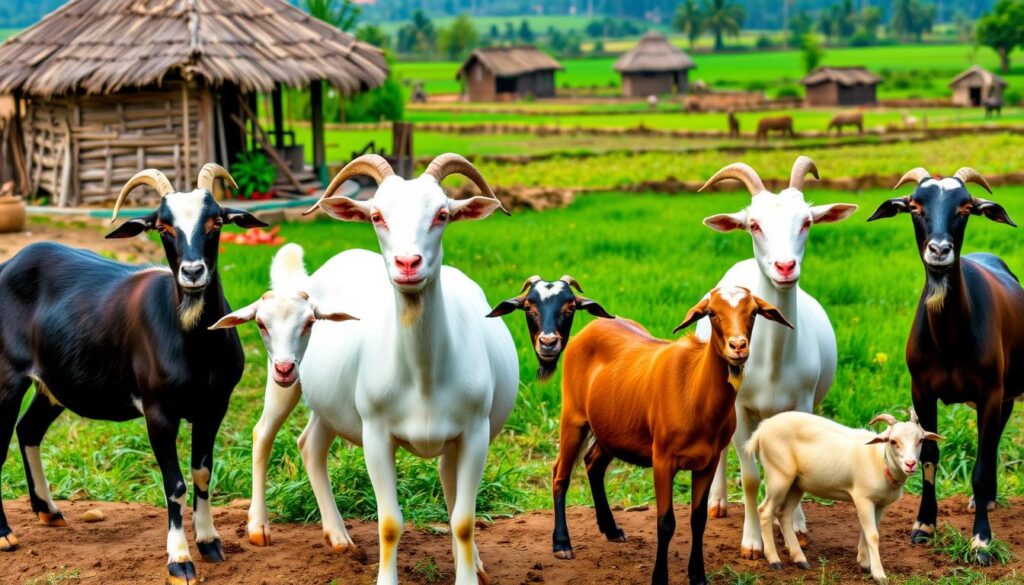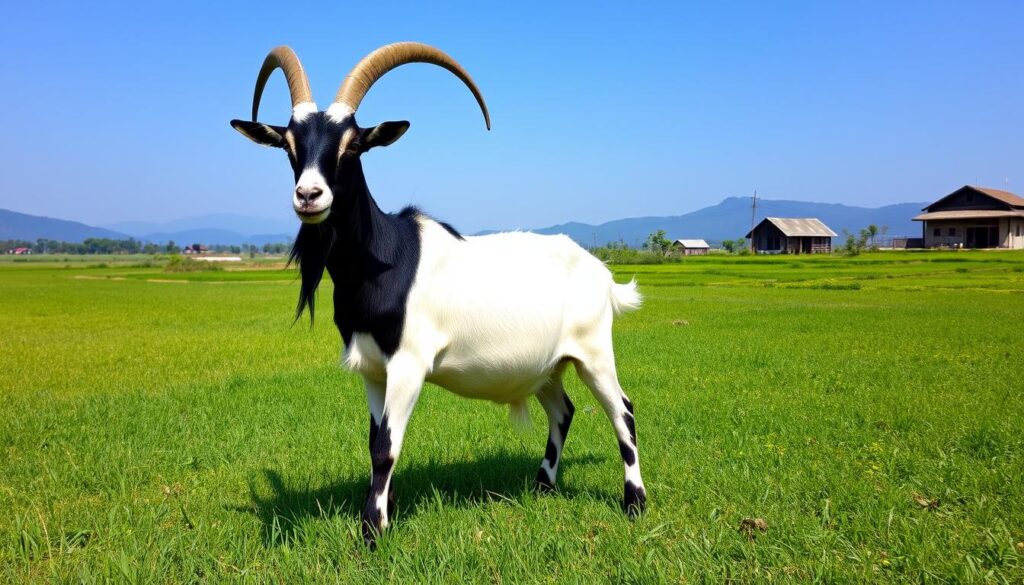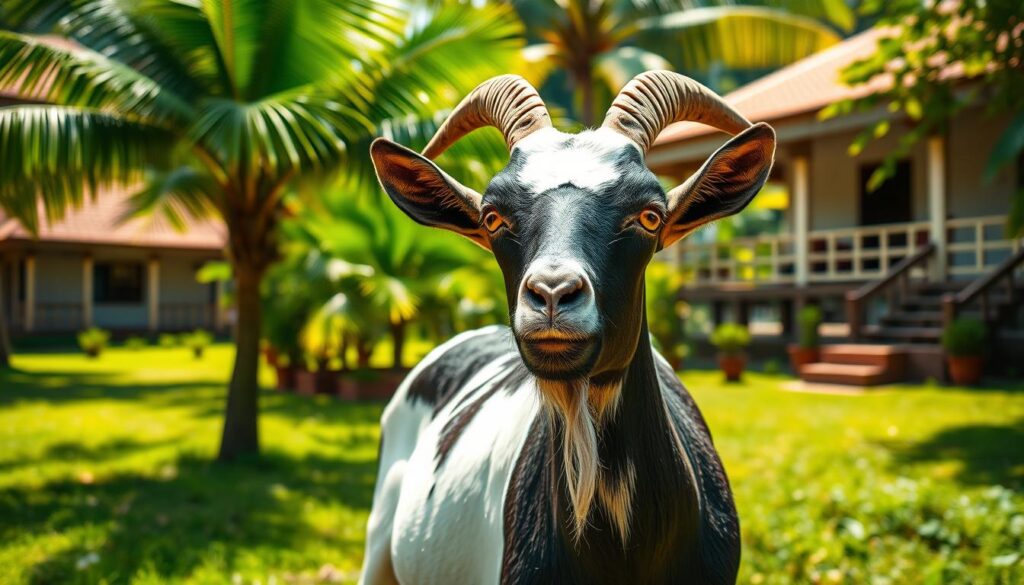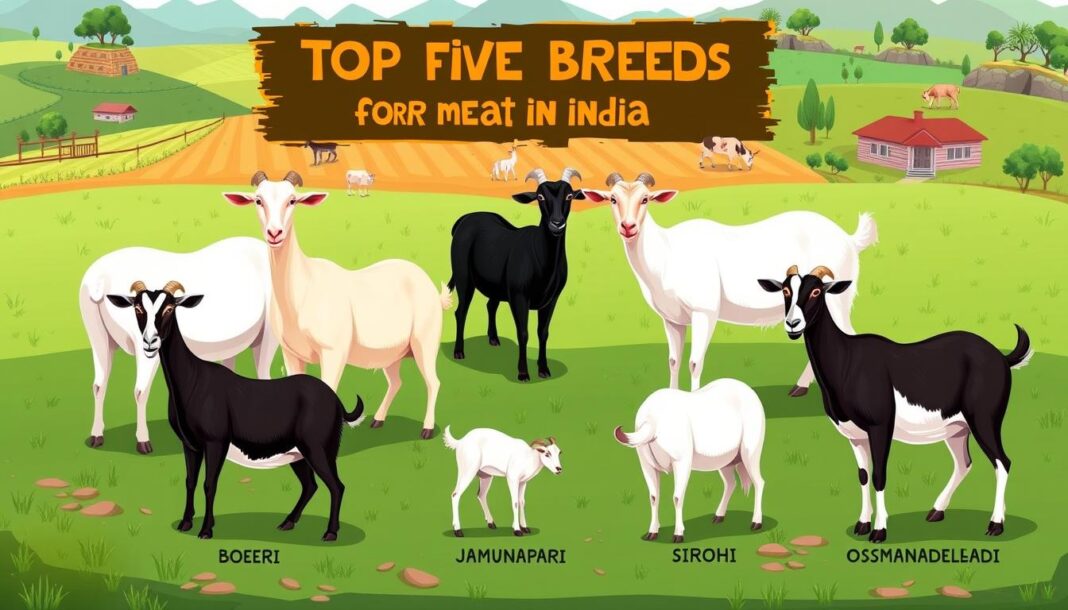Which Goat Is Best for Meat in India
India has a wide variety of goat breeds, with 37 registered ones across the country. Some excel in milk, while others are perfect for meat. If you’re into goat farming for meat, knowing the top breeds is key. This article will look at the top 5 Indian goat breeds known for their great meat quality.
Goat farming is ancient in India, providing valuable products like milk, meat, skin, and fur. Breeds vary in their uses, with some being better for meat. We’ll dive into the top meat goat breeds in India, their traits, and what to consider when picking the best for meat.
India is a big player in goat meat production, making about 4 million tonnes yearly. The National Sample Survey Office (NSSO) says goat meat consumption is growing fast, at 6% annually. This shows a big demand for this tasty and healthy protein.
Introduction to Goat Farming in India
Goat farming is big in India, where dry land farming is common. It’s a hit with small farmers because it’s cheap to start and profitable. Goats give meat, milk, and manure, making farming them a good business.
Advantages of Goat Farming in India
Goat farming in India has many benefits for farmers:
- High demand for goat meat: India is a big player in goat meat production, ensuring a steady market.
- Availability of financial assistance: The Indian government offers schemes and subsidies to help farmers start and grow their goat farming business.
- Adaptability to different climates: Goats can do well in various climates, fitting well in different parts of India.
- Multiple income streams: Goats give meat, milk, and manure, providing farmers with several ways to make money.
- Low maintenance requirements: Goats need less space, food, and care than other livestock, making them perfect for small farms.
The guide on starting goat farming shows the big opportunities and profits in this field. It’s a great choice for those wanting to start in agricultural business.
Popular Meat Goat Breeds in India
India has many goat breeds, each with special traits for different uses. Some breeds are known for their great meat production and quality. Let’s look at some of the best goat breeds for meat in India and why they’re top choices.

The Black Bengal is a famous meat goat in India. It’s small, grows fast, and has a high birth rate. These goats do well in different climates and are loved for their lean, tasty meat.
The Jamunapari, or “King of Indian Goats,” is another top meat producer. These big goats can weigh up to 80 kg for males and 60 kg for females. They give a lot of milk and are known for their high-quality meat.
The Beetal goat comes from Pakistan but is also popular in India. These goats are good for both meat and milk. They are strong, fertile, and give a lot of milk and meat.
Malabari goats are from Kerala and are known for their adaptability. They have horns and are good for meat and milk. They weigh about 40 kg for males and 30 kg for females.
The Sirohi goat is from Rajasthan and is known for its hardiness. These goats can weigh up to 50 kg for males and 30 kg for females. They give a lot of milk and are prized for their meat.
These are just a few of the many meat goat breeds in India. They are known for their excellent meat and are important for farmers. As demand for goat meat grows, these breeds will help meet that need.
Jamunapari – The King of Indian Goat Breeds
The Jamunapari goat comes from the Etawah district of Uttar Pradesh. It’s known as the largest and most majestic goat breed in India. These goats have a white or yellowish-tan coat with light brown spots on their neck and face.

They have long, pendulous ears and a convex “Roman” nose. This makes them look regal and elegant.
Physical Traits of Jamunapari Goats
Jamunapari goats are huge, with males weighing up to 85 kg and females up to 60 kg. Their large, well-built frames make them highly sought-after for meat production. They are truly the “King of Indian Goat Breeds.”
Meat and Milk Yield
Jamunapari goats are also known for their outstanding meat and milk yield. They produce 2 to 2.5 kg of milk per day. This makes them valuable for both meat and dairy production.
Their size, meat quality, and milk yield make them a top choice for goat farmers in India.
| Breed | Average Weight (kg) | Milk Yield (kg/day) |
|---|---|---|
| Jamunapari | 60 – 85 | 2 – 2.5 |
| Beetal | 45 – 60 | 1 – 2 |
| Osmanabadi | 50 – 60 | up to 3.5 |
| Malabari | 30 – 50 | 1 – 1.5 |
| Surti | N/A | 2 – 3 |
Beetal – A Dual-Purpose Breed
The Beetal goat is a standout in India’s goat breeds. It comes from Punjab and Haryana. It looks like the Jamunapari goat, with a red and tan coat on white.
Origin and Characteristics
The Beetal goat is smaller than the Jamunapari. Males can weigh up to 70 kg, and females up to 50 kg. It’s prized for its meat and milk.

A Beetal doe can give 1-2 kg of milk daily. This makes it very useful for farmers and families.
The Beetal goat can live in many different places in India. It does well in dry and temperate climates. This breed’s hardy nature and adaptability make it popular in India.
The Beetal goat’s numbers have dropped a lot. They went down by 23% from 1990 to 1997. By 2013, there were only a few thousand left.
In Pakistan, the Beetal goat is doing better. It’s not at risk there. Its numbers grew from 2 million in 1996 to 4 million in 2006.
India needs to keep its goat breeds like the Beetal alive. They are important for food and culture. The Beetal goat is a key part of India’s livestock.
Malabari – The Pride of Kerala
The Malabari, also known as the Tellicherry, is a unique goat breed from Kerala, southern India. They are medium-sized and come in many colors, from white to black. Adult males weigh 50-60 kg, and females weigh 30-40 kg.

Versatility and Unique Traits
Malabari goats are mainly raised for their meat, which is popular in Kerala. Their skin is also valuable for tanning. They are known for their good reproductive health, often having 2-3 kids at a time. They also produce 1-2 kg of milk daily, making them useful for both meat and milk.
These goats are well-suited to Kerala’s hot and humid climate. They are resistant to diseases and parasites. This makes them a great choice for small farmers and backyard keepers.
Malabari goats are a pride for Kerala. Their unique looks, high reproductive rate, and versatility make them valuable in the state’s goat farming. They are a key asset in Kerala’s thriving goat farming industry.
Which Goat Is Best for Meat in India?
Factors to Consider

Choosing the right goat breed for meat in India involves several important factors. The growth rate, how well they use feed, their adult size, and how well they breed are key. Also, how well they adapt to the local weather and their disease resistance are critical.
Let’s look at the main points to think about when picking the best meat goat breed in India:
- Growth Rate: A good meat goat breed grows fast. This means they can be ready for market sooner, making farming more profitable.
- Feed Efficiency: Breeds that turn feed into meat well are best. They save on feed costs and make more meat from less feed.
- Mature Body Weight: Larger goats give more meat. This is because they have more body mass to turn into meat.
- Reproductive Performance: Breeds that breed well and have more kids are more profitable. This is because they can produce more meat.
- Adaptability and Disease Resistance: Goats that do well in local weather and fight off diseases are best. They stay healthy and productive, even in tough conditions.
By looking at these factors, farmers and business people can find the best goat breed for meat in India. This ensures their meat goat farm is both profitable and sustainable.
Sirohi – A Hardy Breed for Meat Production
If you’re a farmer looking to raise goats for their exceptional meat quality, the Sirohi breed should be at the top of your list. Originating in the Sirohi district of Rajasthan, this medium to large-sized goat is known for its hardiness. It thrives in the dry, tropical desert climate of the region.

The Sirohi goat is a versatile breed, valued not only for its meat but also for its milk production. With a cylindrical body shape, these robust animals are superior meat producers. Adult males average 50 kg, and females around 23 kg in weight. The breed is also praised for its good reproductive performance, with most does giving birth to single or twin kids.
What sets the Sirohi apart is its exceptional adaptability to diverse geographical locations in India. These goats can seamlessly transition to different climates, making them a popular choice for farmers across the country. They are also less susceptible to common diseases compared to other breeds, thanks to their strong immune systems.
Sirohi goats thrive on a balanced diet rich in nutrients, including fresh grass, legumes, and high-quality grains. Regular deworming is also key to prevent parasitic infections. With effective management during pregnancy and a focus on breeding, Sirohi goat farmers can maximize the breed’s meat and milk production.
If you’re a farmer looking to venture into the world of goat farming, the Sirohi breed is undoubtedly a hardy and versatile choice. It can provide you with a reliable source of income through its exceptional meat and milk yields.
Black Bengal – The Most Prolific Breed
If you’re looking for a goat breed that’s great for meat, check out the Black Bengal. This breed comes from eastern India. It’s known for being small but mighty, with top-notch meat quality and breeding skills.

Male Black Bengal goats usually weigh 25 to 30 kg. Females are a bit lighter, weighing 20 to 25 kg. What makes this breed stand out is how many kids they can have at once. It’s not uncommon for them to have 2, 3, or even 4 kids. This makes the Black Bengal goat breed a favorite among small farmers.
The Black Bengal goat is also loved for its meat. The meat is lean and tastes great, which is why people in India prefer it. The breed can handle different weather and doesn’t need much care, making it even more appealing.
The Black Bengal goat is a top choice for meat in India. Its superior meat quality and prolific nature make it a hit with small farmers. They see it as a way to make more money from their goat farms.
Conclusion
India has many goat breeds, each with special traits for different uses. For meat, the Jamunapari, Beetal, Malabari, Sirohi, and Black Bengal are top choices. They vary in size, yield, and how much meat they produce.
Choosing the right goat breed for meat involves looking at several things. These include how much meat they have, how much of that meat is usable, and the quality of that meat. It’s also important to think about what people in your area like to eat and what the market wants.
Success in goat farming comes from picking the best breed and using the best methods. With many high-quality goat breeds in India, the country’s goat meat industry has a lot of room to grow.




